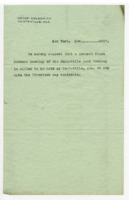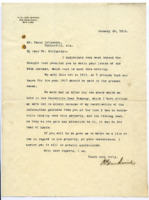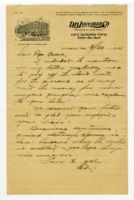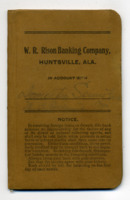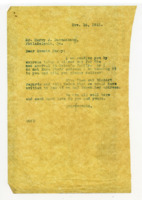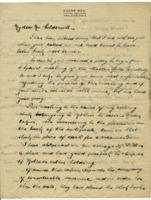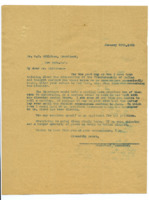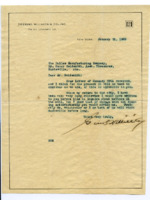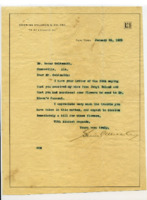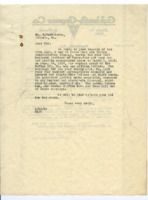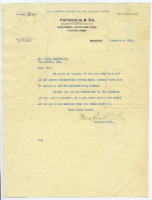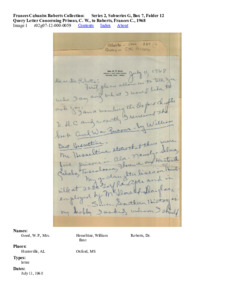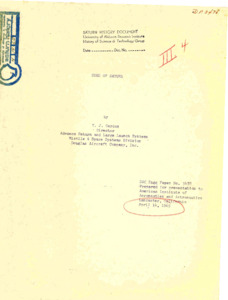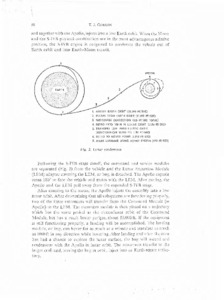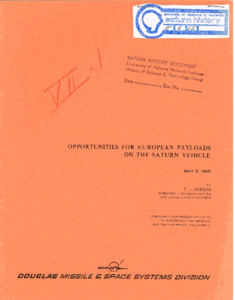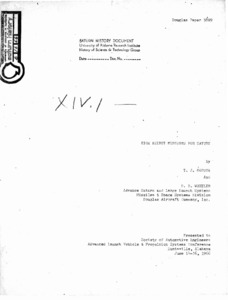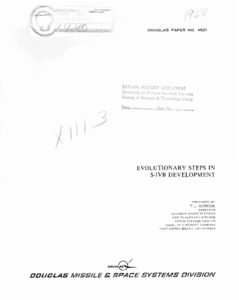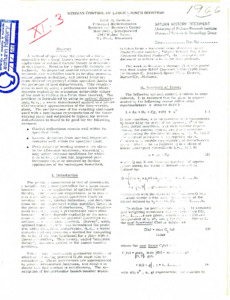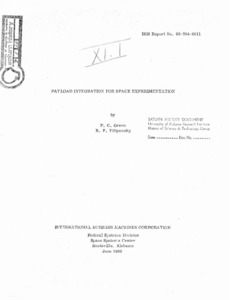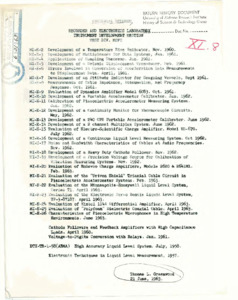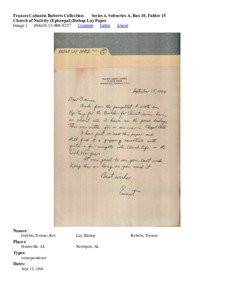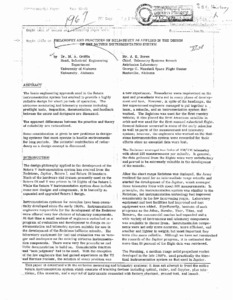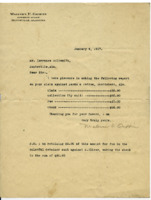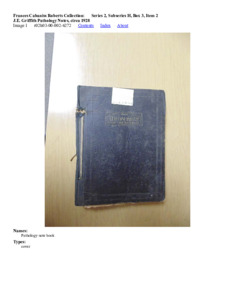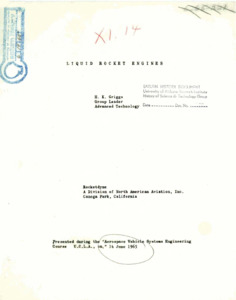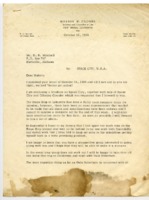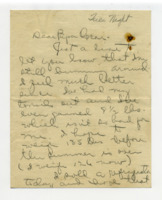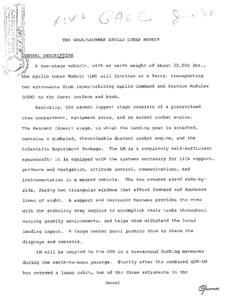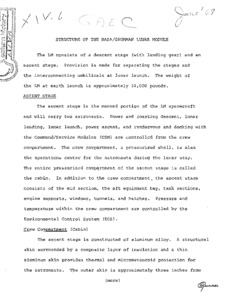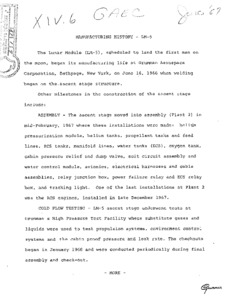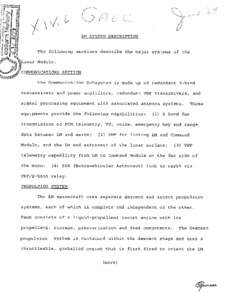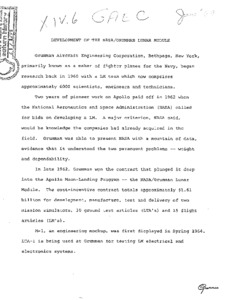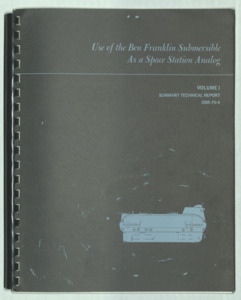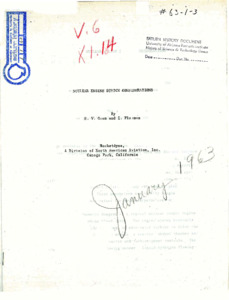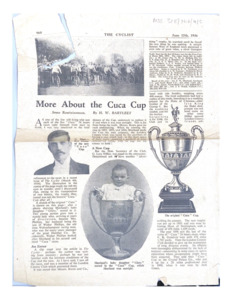
Browse Items (7888 total)
Sort by:
-
Request for Stock Holders Meeting of the Huntsville Land Company.
A request calling for a general Stock Holders Meeting of the Huntsville Land Company issued by Oscar Goldsmith. The second document contains signatures of Oscar Goldsmith and Solomon Plant with a handwritten note that reads: "Please sign this and have Mr. Plant sign". -
Letter to Oscar Goldsmith from H. B. Smith and from Oscar Goldsmith to S. M. Milliken.
In this letter, H. B. Smith responds to a previous letter from Goldsmith regarding the sell of a lot of land in 1916, two years previous. He also details an offer for the stock he currently holds in the Huntsville Land Company that he will be refusing. The second letter is from Oscar Goldsmith to S. M. Milliken regarding the shares that Mr. Smith wrote about and them receiving multiple bids on the stock. He informs Milliken that Mr. Rison will be taking part in it as well. -
Correspondence between Ed and "Papa Oscar".
These first two letters, written by Ed to "Papa" Oscar Goldsmith detail paying off land notes to get money for possible "urgent purpose[s]". The second letter discusses a charge Ed put in the ledger and the hope to "improve things" with his business. The next letter is also from Ed. In this letter, Ed discloses information regarding his lack of a permanent place and inquires if he should sell the property on Clinton Street and his car. The final two letters are written by an unknown author, but contain information from Oscar to Ed in reponse to Ed's letters. The letters advise Ed not to sell the house on Clinton Street as it would sell for less than he owes on it at the time, but does advise to sell his car. It also tells of payments made by Oscar at the request of Ed. It discloses details about Ed's financial situation. The second letter regards a dividend Ed received from the Wonderfield Oil Co. along with a note that "Papa" is feeling better. -
Check from Oscar Goldsmith to W. R. Rison Banking Company.
A check from Oscar Goldsmith for $259.51 to W. R. Rison Banking Company, signed on the back by R. E. Sessions. The second check is blank on the front with a handwritten note on the back for the following day. The writing is difficult to read but notes something about one dollar for or from Oscar Goldsmith, also signed by R. E. Sessions. -
Domestic Science Fund financial account book with W. R. Rison Banking Company.
This book details the financial account of Domestic Science Fund, owned by Oscar Goldsmith. -
Letter to Harry Dannanbaum from Oscar Goldsmith.
Oscar Goldsmith informs Harry that he is sending a silver cup for the new baby in Helen's family and, because he does not have their address, is requesting that Harry deliver it for him. -
Correspondence between Edgar Weil and Oscar Goldsmith, and Oscar Goldsmith and Harry.
In this letter, Edgar Weil gives Goldsmith information regarding the sale of his mother's stocks in the Chelten Hills Cemetery Company, as Goldsmith is unable to attend and will need a proxy, and the reasoning behind the call to change the per value of the stock. Weil states that the Company does not earn any return for their stocks and so he is selling the stocks for a low price per share due to the fact that "nobody will ever get a cent for these holdings." The second document is a letter from Oscar requesting a proxy for the meeting, and Harry's response to be Oscar's proxy. The final documents are signed and blank contracts appointing attorneys to vote for the decrease in per value of the capital stocks at the stockholders meeter. -
Correspondence between G. H. Milliken and Oscar Goldsmith about the Treasurership of Dallas Mnfg. Co.
These letters discuss the appointment of a new treasurer of Dallas Mnfg. Co. to succeed Mr. Rison. Oscar Goldsmith offers himself as an applicant for the position in the first letter. The second letter is Milliken's response to the topic. He states that Mr. Rhett has been selected for some time now while Mr. Rison was still there. Milliken thanks Goldsmith for his willingness to take on more work and hopes he will continue as Assistant Treasurer as he deems it "unwise for a man of your age" to take on additional responsibilities. Goldsmith replies in the final letter expressing happiness at Mr. Rhett's appointment and mentions the already-scheduled Director's Meeting. -
Correspondence between G. H. Milliken and Oscar Goldsmith about a visit to the mill in Huntsville from Milliken and Mr. Winchester.
Milliken writes to Oscar Goldsmith in the first letter stating that he hopes to visit the Huntsville mill with Mr. Winchester soon. Goldsmith responds that he would be glad to have them visit. -
Correspondence between G. H. Milliken, W. E. Winchester, and Oscar Goldsmith.
Correspondence between G. H. Milliken, W. E. Winchester, and Oscar Goldsmith regarding flowers bought for the funeral of Mr. Rison. -
Letter to K. Ward-Smith from Oscar Goldsmith.
A letter from Oscar Goldsmith to K. Ward-Smith regarding capital stock of the Dallas Mfg. Co. -
Correspondence between Hotchkin and Co. and Oscar Goldsmith.
The letters detail information about Dallas Manufacturing Co. stocks being sold. This set of documents also includes a check for the forty shares. -
"Engineering Safety Into Missile-Space Systems."
Safety Engineering, as applied to complex missile and space systems, has developed a new methodology referred to as "System Safety Engineering." The requirement for a comprehensive approach to safety which is included as a contractually covered adjunct to the design, development, and operational phases of a systems life cycle has become apparent from costly missile mishap experience. The general concepts and accomplishments of this new engineering discipline are described along with possible beneficial relationships with Reliability and other recognized organizational elements engaged in safety related activities. -
"Uses of Saturn."
Saturn and Apollo hardware will not have realized their ultimate potential for space exploration after the project lunar landing is complete. To accomplish the Apollo lunar landing program, an immense backlog of technology, facilities, and booster capability will have been built up, and we believe proper utilization of this resource will fill the needs for planetary, lunar and earth orbital space exploration for years to come. -
"A survey of propulsion problems as related to space vehicle design."
Incomplete document. Displays errors in space-vehicle design as they relate to space travel. -
"Opportunities for European Payloads on the Saturn Vehicle."
Prepared for presentation to the Eurospace Conference. In this paper, we will not deal with the first two questions, which must be of interest to every potential experimenter, but only with the last question of vehicle availability. -
"High Energy Missions for Saturn."
Presented to Society of Automotive Engineers, Advanced Launch Vehicle & Propulsion Systems. When the Apollo lunar landing project is complete, the Saturn and Apollo hardware will only have begun to realize their ultimate potential for space exploration. The immense reserve of Apollo technology, facilities, and booster capability can then be directed to the achievement of national goals which lie far beyond the initial lunar landing. In achieving the Apollo lunar objectives, large investments will have been made in launch facilities, tracking systems, propulsion techniques, reentry systems, lunar landing systems and rendezvous technologies. Although developnent in these specialized areas has been tailored to the needs of Apollo, numerous studies by NASA and industry have demonstrated the feasibility of using the spacecraft, launch vehicles, and operating techniques for missions far more complex than lunar landings. Amortization of this hardware will prove cost-effective for missions of more sophisticated applications. -
"Evolutionary Steps in S-IVB Development."
The injection stage of a multistage launch vehicle must be partially a velocity stage and partially a spacecraft; it must not only boost the payload, it must also perform cooperative mission operations with the payload after orbital insertion. These hybrid requirements result in intrinsic stage versatility which permits consideration of new and challenging missions for the stage which were unanticipated during initial design.; Prepared by T. J. Gordon, Director, Advance Space Stations and Planetary Systems, Space Systems Center, Douglas Aircraft Company, Huntington Beach, California. -
"Minimax control of large launch boosters."
Keith D. Graham is principal mathematician, Systems and Research Center, Honeywell, Inc., 2345 Walnut Street, St. Paul, Minnesota.; Work done under NASA contract NAS 8-11206 from the George C. Marshall Space Flight Center.; ABSTRACT: A method of specifying the gains of a linear controller for a large launch booster using a new application of optimal control theory is described in this paper. Results for a specific example are included. An important control requirement is to maintain cost variables (such as bending moment, engine gimbal deflection, and lateral deviation from desired trajectory) within specified limits in the presence of load disturbances. This requirement is met by using a performance index which depends explicitly on maximum achievable values of the cost variables in a finite time interval. -
"Payload integration for space experimentation."
Space experimentation requires an increasingly complex planning and systems engineering effort to meet the demand for highest precision and reliability of all measurements and observations. A companion paper discusses the interfaces between the scientific/technical areas of space experimentation and the instruments, subsystems and support systems within the spacecraft. This paper deals with the organization and the procedures which are needed to perform the difficult payload integration process for space experimentation. In the course of this process it is necessary to define the experiments completely, to describe all instruments in terms of engineering specifications, to investigate the commonality of equipment, to group the experiments into mission compatible payloads, to specify acceptable loads on all subsystems and astronauts (when present) and to plan for all contingencies during the flight. -
Technical Reports" Bibliography.
Bibliography of technical reports from 1957-1963 -
Oral History Interview With Bran Griffin
Bran Griffin was born in Medford, Oregon. His father was in the military, so they moved around a lot. Bran went to the University of Texas his first year of college, and he studied Architecture. Then, he graduated college with a degree in Architecture from Washington State University. He then went to graduate scholl in Southern California, and he received a fine arts degree. After this, Bran wanted to get a degree in something a little more stable, so he went back to school to get his master's degree in Architecture. After this, Bran was on a shuttleship for a couple of years in Rome, and then he came back to start his career in teaching Architecture. Even though he was teaching Architecture, he had an intense passion for space. Because of this passion, he started to become involved with the Johnson Space Center with a faculty fellowship. Bran was in their Spacecraft Design Division. Since he wanted to be closer to be a part of the Space Industry, he decided to move to Washington State. After a while of working in Washington State, he received a job offer from Boeing in Hunstville, AL and began his career there being involved with the space station.Tags Oral History -
"Philosophy and practices of reliability as applied in the design of the Saturn Instrumentation System."
The basic engineering approach used in the Saturn instrumentation system has evolved to provide a highly reliable design for short periods of operation. The airborne measuring and telemetry systems including preflight tests, inspection, documentation, and feedback between the users and designers are discussed. The apparent differences between the practice and theory of reliability are rationalized. Some consideration is given to new problems in designing systems that must operate in hostile environments for long periods. The potential contribution of redundancy as a design concept is discussed.; This paper is concerned with the airborne measuring and telemetry systems; it does not attempt to treat the entire Saturn instrumentation system which consists of tracking devices including optical, radar, and Doppler, plus television, film cameras, and a myriad of instruments connected with factory checkout, ground test, and launch. -
Fee report for a claim suit filed by Lawrence Goldsmith against H. Oliver with Parks & Cotton.
This document contains a detailed breakdown of the fees associated with the "unlawful detainer suit" filed by Lawrence Goldsmith against H. Oliver. -
"Liquid Rocket Engines."
This paper presents a discussion on liquid propellant rocket engines. The first part contains a discussion on liquid propellants, including a description of various propellant types such as cryogenic, storable,bipropellant, and monopropellant. This part also points out desirable physical properties and includes a section on performance outlining the methods by which performance is calculated and shows performance for various liquid rocket propellant combinations. -
Personal letter to "Papa Oscar" from grandson Oscar.
This personal letter to Oscar Goldsmith from his grandson, also named Oscar, details the removal of young Oscar's tonsils and his gaining eight and a half pounds. He also writes of his first refrigerator sale and his hopes to sell more, though he is "no salesman". He conveys some information from his mom and thanks him for making her trip to New York possible. Finally, young Oscar thanks Papa Oscar for paying his tonsil removal bill, and promises that he can take care of his dentist bill. -
"The NASA/Grumman Apollo lunar module"
Handwritten in pencil on the document. Describes the layout and function of various sections of the Apollo lunar module. -
"Structure of the NASA/Grumman lunar module."
Describes the structure and function of each part of the NASA Lunar Module -
"Manufacturing history - LM-5."
Essay that focuses on the achievements of the Grumman Aerospace Corporation. -
"LM System Description."
Report that describes the major systems of the Lunar Module. -
"Development of the NASA/Grumman Lunar Module."
Paper regarding the actions and achievement of the Grumman Aerospace Corporation. -
"Nuclear engine design considerations."
The intent of this paper is to examine the static test countdown organization and discuss the need for a systematic method to organize a countdown. -
Receipt of payment from E. H. S.
Receipt of payment of $8.50 from E. H. S. signed by Walter Gurley. -
More About the Cuca Cup
This is an article about the Cuca Cocoa Challenge Cup over 40 years after the event took place and specifically discusses the second cup and the challenges that led the demise of the Cuca Cocoa Challenge series.
